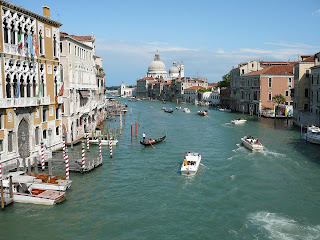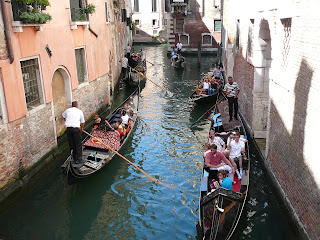 Florence and Pisa
Florence and PisaMonday
After dropping off the Smart Car we made the short walk to the Hotel Vasari, where we were delighted to find friendly and helpful hotel staff, a big, clean, comfortable room, with its own bathroom and a safety deposit box - it was like Christmas, and it was almost half the price of the Venice hotel, which was less than impressive. On top of that, breakfast was included! We would definitely recommend anyone visiting Florence to stay at Hotel Vasari. Aside from all those things we have just mentioned, it is ideally situated close to the centre of the city and right next to the main train station.
We freshened up and set off to find some dinner. We did not have to go far, as we found a brilliant little restaurant just down the road from the hotel, where we had some great bread and olive oil, pasta, lasagne, good Italian wine and tiramisu for dessert. We ended a long day by checking out the magnificent and monstrous Duomo cathedral by night. It is simply breath-taking.
Tuesday
On Tuesday morning we caught a train from Florence to Pisa, just over an hour away, to visit the famous Leaning Tower of Pisa. We had been told that there was not really anything else to see or do in Pisa besides the Leaning Tower, and we did not have loads of time in Florence so we were only in Pisa for a couple of hours.
The Leaning Tower is actually the free-standing bell tower for the cathedral of Pisa. It is just one of the splendid religious buildings in the Campo dei Miracoli (Field of Miracles). It is partnered by the cathedral (begun in 1063), the baptistery (1152-1284) and the Campo Santo cemetery (begun in 1278). All the buildings of the Field of Miracles lean because of their shallow foundations and sandy silt subsoil, but none tilts so famously as the tower. The Leaning Tower was begun in 1173 and it began to tip sideways before the third storey was completed. Even so, construction continued until its completion in 1350. Recent engineering interventions have corrected the tilt by 38cm and the tower was reopened to the public in December 2001 after being closed for several years. The top of the tower is now 3.9 metres from where it would stand if the tower were perfectly vertical.
We were fortunate enough to walk on the sacred grass of the Field of Miracles to take some photos from the best spots before the whistle-blowing police arrived and cleared all of the tourists off the grass. We even joined in the fun of taking cheesy photos 'pushing the tower over' or 'trying to hold it up' as seems to be obligatory for visiting tourists. For obvious reasons they only let around 30-40 people climb the tower each hour and you need to book tickets in advance and then queue for ages for the privilege. As time was fairly short, we decided not to go up the tower. We enjoyed walking around admiring the buildings and gazing at one of the world's most famous structures. Then it was time to catch the train back to Florence to take in another world famous sight.
We grabbed a quick lunch at a pizzeria and then checked out the markets and some other shops in the city centre on our way to the Galleria dell'Accademia. We had purchased tickets online a couple of weeks in advance, which allow entry at a specific time. We were grateful we had, as the queue for people without tickets stretched about 40 metres down the road and did not appear to be moving. We were let straight in at 4pm to explore the gallery.
The gallery was founded in 1563 and was the first school in Europe set up to teach the techniques of drawing, painting and sculpture. The art collection displayed in the gallery was formed in 1784 with the aim of providing the students of the academy with material to study and copy. Perhaps the most famous piece of art of all dominates the collection, Michelangelo's David. The massive statue (5.2m tall) was completed in 1504, when the artist was just 29 years old. It depicts the biblical hero who killed the giant Goliath. It was commissioned by the city of Florence and placed in front of the Palazzo Vecchio in the Piazza della Signoria. In 1873 it was moved to the Accademia to protect it from weather and pollution. A replica of David is now in its original position in the piazza and another replica stands in the Piazzale Michelangelo.
They have positioned David brilliantly, at the end of a long corridor, so that you turn a corner and walk towards it down the corridor. It is beneath a glass ceiling, which lets natural light down on the statue. You can walk right around the statue so you can view it from all sides and angles etc. We probably looked at it for 20 minutes or more. It really is magnificent. The gallery contains some other quality art, including a collection of Byzantine religious art. We were also treated to a temporary exhibition of photographer Robert Mapplethorpe's "Perfection in Form".
After our gallery visit, we bought some ham, cheeses, bread and a bottle of wine and we walked across to the other side of the Arno River and up a steep hill to the Piazzale Michelangelo (Michelangelo Square). We had a really nice picnic dinner overlooking the city of Florence. After dinner we were treated to a beautiful sunset over the Tuscan hills.
Wednesday
On Wednesday morning, we started the day with another great breakfast in the hotel - croissants with nutella, bread and jam, cheeses, cereal, juice and coffee. Then we set off for the Duomo cathedral. Right in the heart of Florence, Santa Maria del Fiore (or Duomo) dominates the city with its enormous dome. Construction on the Duomo began in 1296 and was completed structurally in 1436 with the dome engineered by Filippo Brunelleschi. The dome itself was built between 1420 and 1436. The enormous dome weighs 37,000 tonnes and contains more than 4 million bricks.
Firstly we tackled the dome, climbing the 463 steps to the top. Halfway up in the internal gallery at the base of the dome, where we got a great view of the Last Judgement frescoes by Vasari on the inside of the dome. The frescoes included scenes of Hell, which were particularly graphic and gruesome. Right at the top of the dome from the external viewing gallery, we had magnificent views right over Florence and beyond to the hills surrounding the city. The top of the dome is the highest point in Florence, even a few metres higher than the 85 metre-high bell tower standing next to the Duomo.
Back on ground level we joined the queue to tour the inside of the Duomo. The cathedral is built as a basilica, with a nave and two aisles, forming a Roman cross. Its dimensions are enormous: 153 metres long, 38 metres wide, 90 metres wide at the crossing. The height of the arches in the aisles is 23 metres. The Duomo can hold up to 20,000 people. The Gothic interior is vast and gives an empty impression. Above the main door is the colossal clock face. This one-handed liturgical clock shows the 24 hours of Italian time, a period of time ending with sunset at 24 hours. This timetable was used until the 18th century. This is one of the few clocks from that time that still exist and are in working order.
In front of the Duomo is the Baptistery, one of Florence's oldest buildings dating from possibly the 4th century. Its dome ceiling is decorated by 13th century mosaics of, again, The Last Judgement. The baptistery is most famous, however, for its East Doors, commissioned in 1425 and completed 27 years later. The gilt doors, often dubbed the "Gates of Paradise", depict 10 scenes from the Old Testament of the bible.
After our Duomo morning, we walked through the markets, where we picked up a book and a scarf for Megan, and then had lunch at a pizzeria in the city centre. We had booked tickets in advance for the Uffizi Gallery, one of the oldest and most famous art galleries in the western world. The Uffizi was built between 1560-80 as a suite of offices for Duke Cosimo I's new administration. From 1581 Cosimo's heirs used the well-lit offices to display the Medici family art treasures. There are works by Leonardo, Michelangelo, Raphael, Rembrandt and Botticelli. Botticelli's 'The Birth of Venus' (1485) is probably the most famous piece housed in the Uffizi.
It was a very hot day and the gallery was crowded and stuffy, so once we were finished at the Uffizi, we got some cold drinks and sat in the shade in the Piazza della Signoria. The piazza is the main square in Florence, where the majestic Palazzo Vecchio (town hall) stands proudly. In front of the town hall are the Neptune Fountain, a copy of The Marzocco (Donatello's heraldic lion), a copy of Michelangelo's David and Bandinelli's Hercules and Canus. Next to the town hall is the Loggia dei Lanzi, a covered area full of ancient Roman statues.
We were bemused by the two policemen/security guards patrolling the covered area blowing whistles and yelling at tourists for breaking the bizarre rules in place. Apparently sitting on the steps is not allowed, eating and drinking is definitely not allowed, and our personal favourite, removing footwear will get you a severe blast on the whistle. Wearing jandals is fine, but as soon as your foot is removed from your jandal, big trouble!
We had dinner at a nice little restaurant near our hotel in the Piazza Mercato Centrale. After dinner we went for a long walk back through the city to the world's finest gelato shop, Vivoli, as recommended by our friend Libby, where we were had fantastic gelato for dessert.
Leaning
Tower
Tim at the
Field of
Miracles
Megan
leaning
Palazzo
Vecchio at
Piazza della
Signoria
Neptune
Fountain,
Piazza della
Signoria

Picnic dinner,
Piazzale
Michel-
angelo

View over
Florence

Copy of
David

Duomo


Sunset
over
Florence

Megs at
top of
Duomo

Inside of
the dome

Inside the
Duomo

Main
entrance
to Duomo


Ponte
Vecchio
bridge

Tim on
Ponte
Vecchio



















 Venice
Venice

















